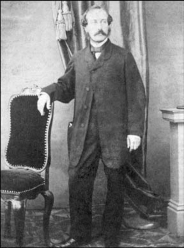- MULVANY T J
- IRELAND (see also List of Individuals)\
 .. 1821 Dublin/IE - 25.7.1892 Kati-Kati/NZ\The advance of the rational formula in hydrology is greatly associated to Irish civil engineering of the 1840s. The method, in brief, is to design drainage channels carrying off a percentage of recorded daily maximum rainfall. It was assumed that the total rainfall was disposed of evaporation, infiltration and stream flow, with the first two losses being constant throughout the year. Thus, it was reasoned that if a certain percentage of the total annual precipitation found its way to the stream, a similar proportion of daily rainfall would do likewise.\Thomas John Mulvany, younger brother of William Thomas (1806-1885), was the originator of the present so-called rational method. In his 1851 paper, he laid the foundation of the method. Mulvany pointed out therein the necessity of a general and an uniform method of collecting precipitation data, to establish rules for engineering practice. For a maximum rainfall, "a combination of circumstances as to the fall of rain and the peculiar character of the catchment may be required, that may not occur more than once perhaps in two or three years, but which is nevertheless necessary that he should provide for". Mulvaney can also be credited with the first correct understanding of the hydrologic concept of the time of concentration as applied to the rational method. Further advances in the rational formula were provided by Robert Manning (1816-1897) in 1851, thereby neglecting the effects of evaporation and infiltration; Emil Kuichling (1848-1914) in his 1889 paper; and David Ernest Lloyd-Davies (1875-1932) in his 1906 paper. The rational formula should have rather been named after Mulvany, therefore.\Biswas, A.K. (1970). History of hydrology. North-Holland: Amsterdam.Mulvany, T.J. (1848). On the drainage of the Mantua turloughs in the County of Roscommon and the formation, for that purpose, of a deep cut through Kinclare Bay. Trans. Institution Civil Engineers Ireland 3: 34-56.Mulvany, T.J. (1851). On the use of screw pumps for unwatering purposes. Trans. Institution Civil Engineers Ireland 4: 38-44.Mulvany, T.J. (1851). On the use of self-registrating rain and flood gauges. Trans. Institution Civil Engineers Ireland 4: 18-33.Schmidt-Rutsch, O. (2003). William Thomas Mulvany. Rheinisch-Westfälische Wirtschaftsgeschichte 42. Rheinisch-Westfälisches Wirtschaftsarchiv: Köln. P http://www.britischebotschaft.de/statevisit/de/ http://72.14.207.104/search?q=cache:xCsy3HSwPiwJ:www.britischebotschaft.de/statevisit/de/ articles/nrw_gb.htm+thomas+mulvany&hl=de&gl=ch&ct=clnk&cd=10 P
.. 1821 Dublin/IE - 25.7.1892 Kati-Kati/NZ\The advance of the rational formula in hydrology is greatly associated to Irish civil engineering of the 1840s. The method, in brief, is to design drainage channels carrying off a percentage of recorded daily maximum rainfall. It was assumed that the total rainfall was disposed of evaporation, infiltration and stream flow, with the first two losses being constant throughout the year. Thus, it was reasoned that if a certain percentage of the total annual precipitation found its way to the stream, a similar proportion of daily rainfall would do likewise.\Thomas John Mulvany, younger brother of William Thomas (1806-1885), was the originator of the present so-called rational method. In his 1851 paper, he laid the foundation of the method. Mulvany pointed out therein the necessity of a general and an uniform method of collecting precipitation data, to establish rules for engineering practice. For a maximum rainfall, "a combination of circumstances as to the fall of rain and the peculiar character of the catchment may be required, that may not occur more than once perhaps in two or three years, but which is nevertheless necessary that he should provide for". Mulvaney can also be credited with the first correct understanding of the hydrologic concept of the time of concentration as applied to the rational method. Further advances in the rational formula were provided by Robert Manning (1816-1897) in 1851, thereby neglecting the effects of evaporation and infiltration; Emil Kuichling (1848-1914) in his 1889 paper; and David Ernest Lloyd-Davies (1875-1932) in his 1906 paper. The rational formula should have rather been named after Mulvany, therefore.\Biswas, A.K. (1970). History of hydrology. North-Holland: Amsterdam.Mulvany, T.J. (1848). On the drainage of the Mantua turloughs in the County of Roscommon and the formation, for that purpose, of a deep cut through Kinclare Bay. Trans. Institution Civil Engineers Ireland 3: 34-56.Mulvany, T.J. (1851). On the use of screw pumps for unwatering purposes. Trans. Institution Civil Engineers Ireland 4: 38-44.Mulvany, T.J. (1851). On the use of self-registrating rain and flood gauges. Trans. Institution Civil Engineers Ireland 4: 18-33.Schmidt-Rutsch, O. (2003). William Thomas Mulvany. Rheinisch-Westfälische Wirtschaftsgeschichte 42. Rheinisch-Westfälisches Wirtschaftsarchiv: Köln. P http://www.britischebotschaft.de/statevisit/de/ http://72.14.207.104/search?q=cache:xCsy3HSwPiwJ:www.britischebotschaft.de/statevisit/de/ articles/nrw_gb.htm+thomas+mulvany&hl=de&gl=ch&ct=clnk&cd=10 P
Hydraulicians in Europe 1800-2000 . 2013.
